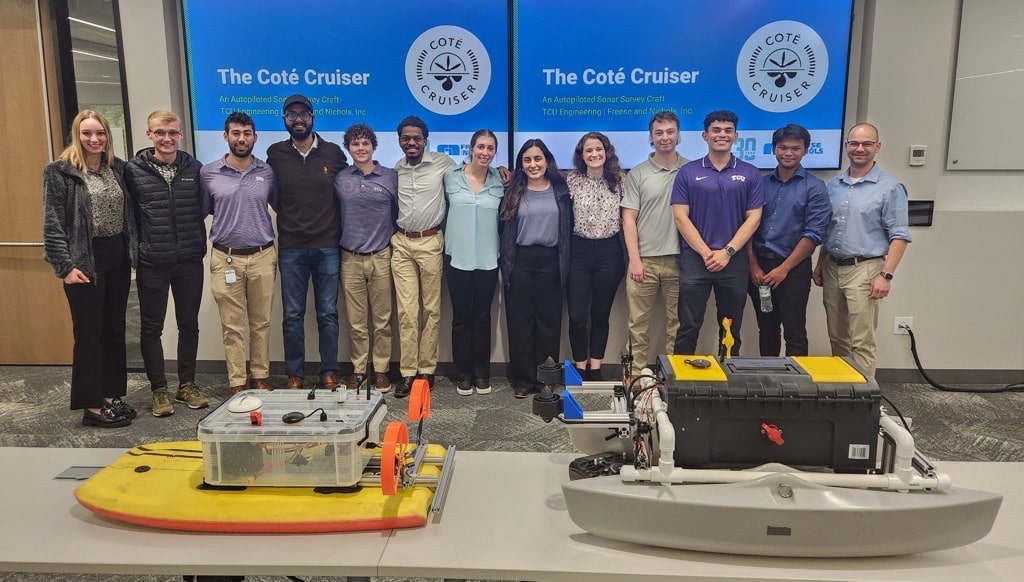R&D Alliance With TCU Builds a Better Sonar Craft
Like some of the best product innovations, the Coté Cruiser side-scan sonar craft originated with giving an engineer an idea.

Designed and built for Freese and Nichols by Texas Christian University students, the sonar surveying tool evolved from a notion that turned into a prototype gadget that helped a private client that led to a research and development grant that funded a collaboration with a senior engineering design class.
The students delivered a completed device in the spring, and it already has been used for a survey on the San Antonio River. The rest of the story is waiting to be written — but here are the opening chapters.
1. It Started With a Pandemic Conversation
During the all-remote-work days of 2020, Freese and Nichols Lead GIS Analyst Brian King and Electrical Engineer Dan Koss chatted about mounting a side-sonar mechanism on a remote-control boat to conduct underwater surveys in shallow water. Not long after, Dan devised a craft in his garage by mounting a $1,300 sonar unit on a boogie board. (A commercial version costs upwards of $30,000.)
Dan named it OWEN: You could call that an acronym for Over Water Engineer Navigation device — or you could imagine a combo of actor Owen Wilson’s quirky characters in the Wes Anderson flick “The Life Aquatic with Steve Zissou” and the Marvel-universe TV series “Loki.”
An opportunity to use OWEN came when a private client needed a reservoir surveyed in a hazard zone off-limits to individuals. The unit showed its utility for our environmental science and water resource services, but it needed refinement. Enter the ongoing partnership Assistant Division Manager Vimal Nair has facilitated with TCU’s engineering program, plus a Freese and Nichols’ R&D grant Dan secured to underwrite having the design class produce a side-scan sonar sequel.
2. Engineering Experimentation and Decision-Making Took Over
The team of 16 students had two semesters and $3,000 dollars to build a better OWEN.
Key requirements included:
- Craft speed of 1-2 meters/second (about 4.5 mph)
- Continuous operation for 30 minutes between battery charges
- Two independent propulsion systems
- Ability to operate in shallow water without getting clogged by vegetation
- Operation using Mission Planner, an open-source flight controller
- Separate power supplies for drive train and data logging
- Base station telemetry reporting
- A user manual and assembly instructions
The students experimented with components; evaluated options based on functionality, ease of operation and cost; tested concepts; made engineering decisions to refine performance; and wrote code for two operating systems.
Divided into four teams to develop different parts of the device — hull & body, propulsion, control systems and sonar — they also confronted real-world challenges of multidisciplinary collaboration, such as understanding how to deliver so other groups could complete their assignments.
Freese and Nichols staff from several areas assisted the effort. For instance, Kelsey Calvez, an environmental scientist/GIS analyst, shared her sonar expertise. Art Director Bobby Nichols designed a special logo.
Dan met with the students regularly, sharing both practical knowledge and encouragement. To add levity, he urged them to give their craft a name that reflected its personality. They called it the Coté Cruiser in tribute to the late René Coté, who was an engineering lab professor and mentor.
“It ended up being more fun than I ever imagined,” Dan said.
During one class, he led the students through a critique of a similar project from another university. The exercise “got them to recognize all the in-depth knowledge they’d gained,” he said.
In March, they presented on their progress to hundreds of Freese and Nichols employees on Continuous Improvement Day.
TCU Engineering Chair Steve Weis praised Dan as “one of the very best customers we have had” during 29 years of senior design projects for his involvement with the students, guidance and inspiration.
“The students enjoyed it and learned a lot about how we think as engineers and how we approach design evaluations,” Steve said. “Maybe the most important thing Dan did for our team was to demonstrate, by example, the joy of design and solving hard design problems.”
3. What’s Next?
The Coté Cruiser has a catamaran hull mounted on pontoons, can operate with either propellers or fans, maneuvers on autopilot or remote-control mode, and delivers real-time sonar depth and temperature readings, which allows for immediate adjustments during a survey.
Freese and Nichols has used the vehicle to survey emergency repairs on a section of the San Antonio River. Dan said the goal is to refine the tool so that it can be applied on other projects by staff with minimal training. Developing a fleet of crafts is a long-term possibility.
